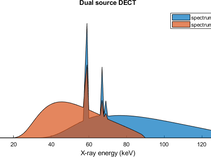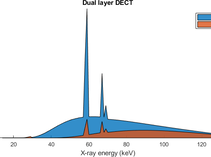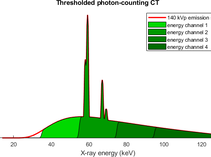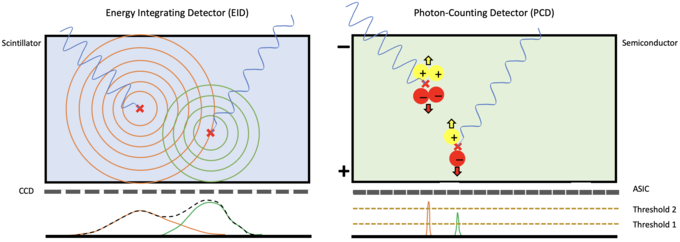Energy Binning vs. Beam-Filtering
Since broad X-ray spectra, without spectral data acquisition and processing, lead to severe beam hardening artefacts, a straightforward solution of the problem is to narrow down the spectra employed in CT imaging. Synchrotron light sources and free electron lasers represent this concept its most extreme manifestation. These huge, multi-billion Euro facilities are capable of producing quasi-monochromatic X-ray beams, but also of extreme brightness and with small angular deviation (denoted as brilliance). However, such sources are completely impractical for medical and laboratory use.
In clinical CT typically high powered X-ray tubes (several to hundreds to kW) are employed in combination with heavy beam filtering (Al, Cu, Sn). Although providing the desired mono-chromatization of the tube spectrum, the filtering entails several adverse effects. For one thing the loss in brightness entails a trade-off between spectrum width, exposure time (hence motion artefacts) and required spot size (hence system resolution). For the other, with the spectra used in clinical setting, beam-hardening artefacts from bone structures are largely suppressed, however at the cost of soft tissue contrast.
Filtered (red) vs. energy-binned (shaded green) X-ray spectrum. Other than permitting discrimination of X-ray quanta by energy, the application of photon counting detectors in CT allows to utilize a larger portion of the X-ray tubes photon flux.
Spectral CT vs. Dual-Energy CT
Photon-counting detectors
As opposed to state-of-the-art scintillating detectors, photon-counting detectors directly convert excitons (charge carrier pairs generated by ionizing radiation) into detector signal. This is achieved by separating the charge carriers by charge sign through an external electrical field. Fast electronics within each pixel are consecutively used to analyze signals generated by individual X-ray interactions, giving spectral and timing information.
Since the motion of the secondary signal carriers, i.e. the generated charge carriers is directed by an external field, the lateral spread within the sensor is small. In contrast, secondary photons generated in a scintillator propagate isotropically within the sensor, leading to significant lateral smearing and a detrimental trade-off between sensor thickness, and therefore absorption efficiency, and image contrast.
Dr. Martin Peter Pichotka
Scientific Lead of the Spectral CT Research Group
Tel.: +49 761 270-39220
E-Mail: martin.pichotka@uniklinik-freiburg.de
Medical Center – University of Freiburg
Dept. of Radiology · Medical Physics
Killianstr. 5a
79106 Freiburg






